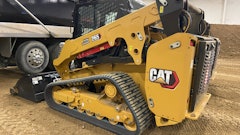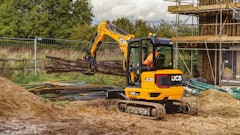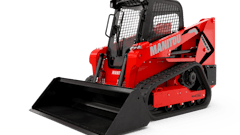
On a Monday morning in May, Bob Loula, vice president of sales for Atlas Bobcat, arrived at the Schiller Park, IL, location to a barrage of phone calls requesting rentals of rubber--tracked compact loaders. “We had so much rain in May,” he says. “On that morning, we were feeling the affects of 4 in. of rain over the weekend. Within a few hours, every one of our tracked machines (30 to 40 of them) was rented out.”
Tracks really seem to shine when the sun doesn’t, says Loula. “When you’re trying to work in inclement weather, there’s just less downtime with a rubber tracked loader,” he says. “We see some customers put two to three times more hours on their compact loaders equipped with tracks vs. skid steers equipped with tires.”
Ron Hoyle, sales representative at Altorfer, a Caterpillar dealer in Peoria, IL, has also seen increased interest and sales of compact track loaders. “We have seen a huge number of inquiries about tracked machines,” he says. “The main advantage is that a contractor can still make money on a rainy day. Contractors in northern climates can also extend their season to about nine months of the year.”
Hoyle cites a recent example. “Just the other day, a customer took delivery of his Caterpillar tracked machine on a day that it was raining. He still headed to the jobsite and proceeded to pull out a wheeled skid steer and a competitive unit with tracks. Then he went to work backfilling around just--poured concrete walls, he explains. “A rubber--tracked compact loader is really a great choice for contractors who want to work even when conditions are muddy.”
Rubber tracks have an advantage over tires in wet ground conditions because their long footprint can bridge a longer surface, keeping the loader afloat and improving mobility. “You can keep working with a track machine long after you’ve had to park one with tires,” says Randy Hrabe, sales manager at Theros Equipment, a Mustang dealership in Lorton, VA.
Plus, extra rubber on the ground spreads the weight of the loader over a larger area for enhanced flotation and reduced ground bearing pressure. That “lighter” touch makes rubber tracks a good match for working on delicate surfaces and grasses where you don’t want to leave any ruts. “With some tracks, you can get ground bearing pressure down to as low as 3.1 psi,” says Hoyle. “You and I are about 7 to 9 psi.”
Other arguments that favor tracked units include increased traction, greater stability, especially on slopes, and a smoother finish when working in dirt.
Turning To Tracks
But, according to Hrabe, just because they’re popular and offer a lot of benefits, that doesn’t mean they’re the right match for your particular job. “Don’t assume anything,” he cautions.
Theros Equipment has sold about 100 compact track loaders in the past two years. Currently, that constitutes about 15% of the company’s entire compact loader sales. “The industry is definitely turning toward tracks,” Hrabe says.
“That’s where we see the biggest growth, and I anticipate that trend will continue for the next several years. Some people say they’ll overtake tires.”
While Hrabe doesn’t make that prediction himself, he admits they’re a nice fit for certain applications. “We concentrate on helping customers sort out which unit -- tracks or wheels -- is their best option,” he says. “You have to get to know their businesses and what they’ll use the machine for.”
The Bobcat specialists at Atlas Bobcat helped Mark Key, Tri--City Excavating, Batavia, IL, with the decision to replace wheeled skid--steer loaders with compact track loaders. “We wouldn’t have anything else,” Key says. “We’re big advocates of the tracks.”
Tri--City focuses on underground excavation for sewer, storm sewer and water lines, as well as for ponds, roads and buildings. It has a Bobcat T300, purchased just a year ago, and a three--year--old Bobcat 864s in its fleet. “We use our compact track loaders for everything,” Key says. “We run them in dirt and on pavement.”
Key appreciates the tracks’ ability to move through sand, pea gravel and wet soil conditions. “They’re especially useful in sand because wheels spin and get stuck,” he says. “And in the dirt, you just can’t beat the tracks. We use them to move a lot of material we couldn’t do with a skid steer equipped with tires.”
Key also uses the tracked machines on hard surfaces. “These are the only Bobcats we have,” he says, “so we need to also use them for jobs such as street cleaning with sweeper attachments. These tracks work fine. And since they’re rubber, they don’t damage sidewalks, curbs and foundations.”
Matt Winfree, owner of ForMatt Bobcat Service, Inc. in Durham, NC, uses a mix of tracks and wheels to move his fleet of Caterpillar compact loaders. His full--service landscape construction company offers a variety of services -- grading, landscaping, retaining walls, grounds maintenance, etc. -- for high--volume (about 800 to 900 houses a year) residential construction.
“We use compact track loaders every day,” Winfree says. “They’re the backbone of our business. A lot of the houses and areas where we work have finished surfaces so the rubber tracks give us the ability to run over the concrete without damaging it.
“If we could get away with it, we’d have nothing but tracks,” he continues, adding that six of his 10 loaders are equipped with rubber tracks. “But we do quite a bit of work on asphalt, so having rubber tires is a necessity. The friction between asphalt and tracks would wear them too fast.”
Room For Both
Loula finds that many of his customers are equipping their fleets with both tracks and tires. “There are definitely certain applications in which each has a benefit,” he notes. “Once you know the end use of the machine, it’s pretty well cut and dried as to whether tracks or tires are better. It’s important for contractors to ask questions before making a final decision.”
Hrabe has seen a similar trend in his area. “Contractors who are going to track units aren’t necessarily trading out of all their wheeled machines.
Tracks are a nice complement,” he says. “A lot of guys will keep a wheeled unit or two for when they run on asphalt, even if they’re totally sold on tracks. Running on asphalt is hard on rubber, so I steer contractors who are doing mostly paving or concrete curb work to tires because maintenance costs will be lower. To replace a set of tracks can cost anywhere from $3,800 to $4,000 compared to $600 to $800 for tires.
“Plus, on hard surfaces, you just don’t gain much performance with tracks so it makes more sense to go with tires,” he adds.
Wheels also make more sense in demolition and recycling applications where sharp objects such as rebar can slice through rubber track.
“It really boils down to application,” says Hrabe. “The harder the surface, the more I tend to steer people to rubber tires. For softer surfaces, I tend to steer them toward tracks.”
For those in between jobs, where you have a greater percentage of time in soft conditions, yet work on some hard surfaces, Hrabe offers suggestions for lengthening track life. “Avoid track spin,” he says. “If you have a pile of gravel on the edge of the road, don’t hit the pile and keep pushing to get a little extra in the bucket. That spins the tracks and can cause premature wear to the rubber. It really boils down to the operator and taking care of the tracks.”
Be Prepared Before You Buy
Dealers recommend asking yourself these questions:






























